“Had you come here a few years ago, all of this would have been dirt.”
It’s a sweltering morning in Mexico and our guide, Manuel, is leading us along a dusty path at the ruins of Teotihuacán, an ancient city 50km northeast of the capital. Already today, we’ve climbed the hazardous steps of what everyone calls pyramids. (They’re not pyramids, Manuel insists, they’re geometric shapes, with no point at the top, and were built to replicate the mountains that flank them.) We’ve learned about human sacrifices, days named after animals, the importance of corn. Now, Manuel is pointing towards a network of low walls, demarking apartments of those who once lived here. No one knows for certain who these people were – they were pre-Aztec, possibly Otomi – but excavations continue to uncover more about their once-powerful civilisation all the time.
I point to the other side of the path, where patches of grass, cactus and agave grow from red dirt. “What about over here?” I ask, jokingly. “What might be hidden under our feet?”
Quite sincerely, without missing a beat, he says “a whole world”.
READ MORE
Indeed, there’s likely far more to be unearthed beneath the soil at Teotihuacán, if only funding would allow (some estimate that only 3 per cent has been explored so far). But Manuel’s projections also seem an apt way to describe Mexico itself; a country you could explore for years and still only scratch the surface.
The good news: direct flights will soon operate from Dublin, with a new Aer Lingus route starting January 2026. The bad news: those flights are to Cancún, the Americanised resort area on the Caribbean coast. Go for the sunsets and the cenotes, but to see the best of Mexico, you need to go further afield.
In May of this year, my husband and I spent five days in Mexico City (or CDMX – Ciudad de México), and five days in Oaxaca de Juárez, the capital of the nearby state of Oaxaca. Connecting flights to CDMX from Dublin are available from a range of carriers. We booked with Iberia, and flew via Dallas, spending about 12 hours in the air, across two flights.
[ Direct flights to Cancún may say more about the US than MexicoOpens in new window ]
Is it dangerous, everyone wants to know upon hearing of our trip, as though we might happen upon a drug cartel at the hotel breakfast. CDMX is the largest city in Latin America. There’s severe wealth inequality, and according to statistics, the crime rate is high, with much of it concentrated in the northern and eastern regions. We stay in the upscale area of Roma Norte. With its tree-lined streets, colourful facades and kitsch Marian shrines, questions of safety seem strange and obscure. Only the roaming pickup trucks upon which groups of policemen stand upright, armed with machine guns, give any allusion to a lurking threat.
Originally built on a series of islands, CDMX now sits on the drained basin of Lake Texcoco, with centuries of history – from Aztec temples, to colonial cathedrals, to modern skyscrapers – layered on top. The city perches more than 2,000m above sea level – higher than San Moritz, higher than Flagstaff, just shy of the famously elevated distance-runner’s haven of Iten, in Kenya. Combine this with a seven-hour time difference, and tiredness is inevitable in the first few days.
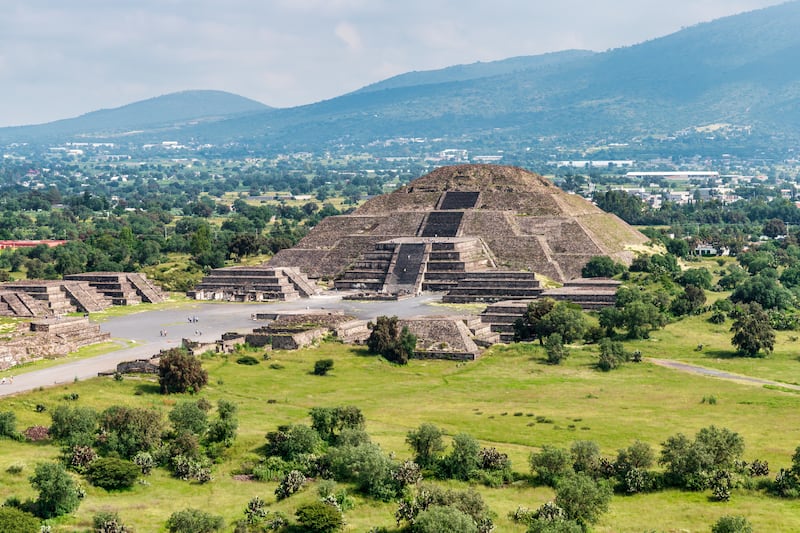
But with jet lag comes blessings. We rise early and drink coffee in Roma Norte’s speciality coffee shops.. We choose the 7am start for a trip to the aforementioned Teotihuacán, beating the crowds and the worst of the day’s heat. A variety of tours are available from sites such as viator.com, getyourguide.com and others. The hot air balloon option is popular among those not terrified of heights, but we choose the half-day tour, for $850 MXN (€39) including shuttle, entrance fee and guided tour, and are not disappointed.
Driving out of the city, its scale announces itself. We pass a colonia populare with a population of around half a million. The valley heaves with squat, colourful cubes.
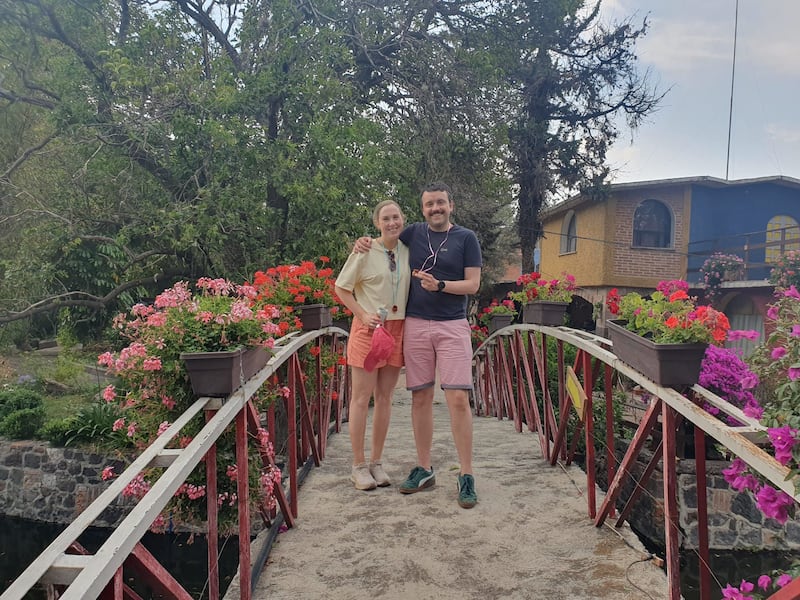
Later that day, we take an Uber to the main square, Plaza de la Constitución. An enormous Mexican flag – possibly the biggest flag I’ve ever seen – floats majestically in the thin air. This is the square you see on postcards and in promotional images, home to the national palace and the Mexico City Metropolitan Cathedral. All around, people fly kites. At the flag’s base, a man lies sleeping.
We walk down a busy street, where shops sell wedding dresses, suits and sunglasses, and street vendors display plastic cups lined with red powdery substance we will later learn is for micheladas, a drink that mixes beer with sweet syrup. In Mexico, if it can be made sweeter, it will. An impromptu mariachi dance party takes place to one side. A motorcycle tears down the road carrying a rottweiler.
The Palacio de Bellas Artes, with its iconic yellow-orange dome, stands gallantly on Avenida Juárez. Several Diego Rivera murals are displayed inside, but it being Monday, the place is closed.
Across the way, Edificio la Nacional, one of several art deco buildings in the city, looks practically quaint compared to the high rises that proliferate. When it was built in 1932, it was the city’s first skyscraper.

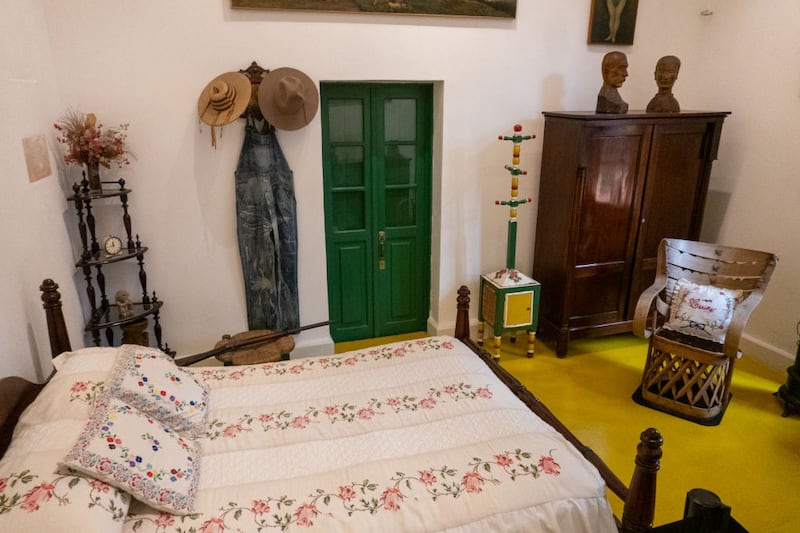
Five days, it becomes clear, is not nearly enough to take in this sprawling metropolis. Two things we decide are unmissable: the Frida Kahlo Museum (my choice) and Lucha Libre (my husband’s). We manage to fit both into one jam-packed day.
The Blue House, or Caza Azul, in which the renowned artist spent most of her life, has been preserved as a museum, integrating some of her best-known artworks. It is situated in the dreamy borough of Coyoacán, not far from the house in which Russian revolutionary, Leon Trotsky, spent three years in political asylum. Both can be visited in the same morning – indeed this is an ideal way to get a picture of the pair’s intersecting lives. (Kahlo hosted Trotsky in the Casa Azul when he first fled to Mexico. The pair are said to have had an affair while she was married to Rivera, and he to Natalya Sedova). Entrance to the Trotsky Museum is pay-on-arrival, at $40 MXN (€2), but for the Kahlo Museum, booking in advance is necessary. Tickets cost $320 MXN (€15) via boletosfridakahlo.org.mx.
After a blissful morning entrenched in bohemian Mexico of the 1930s, we grab lunch at a nearby sports bar, then high tail it back to Roma Norte, where our Lucha Libre tour is meeting. For $1,500 (€70), we get tacos at a local taqueria; beer, mezcal, and pulque (a drink made from fermented sap of the maguey, or agave, plant) at a traditional cantina; a potted history of the sport; tickets to the event; and souvenir masks.
The famous freestyle-wrestling spectacle is the most-watched sport in the country, after football and boxing. In the iconic Arena Mexico, servers walk around selling hot dogs, popcorn, drinks. Women in short red skirts and cropped white T-shirts dance as the equally objectified and scantily clad luchadors make their entrance. There are impressive acrobatics and outlandish storylines. Between fights, a kiss-cam appears on-screen. Everything is incredibly camp. The referee is a large man who can tumble exceptionally well, but never makes it to three when he counts to signal a pin fall. From the bleachers, we bleat chants and whistles we’ve been taught by our guide – the more vulgar the better, we’ve been told, and who are we to disagree.
By the fifth day, we haven’t seen nearly as much as we would like. In a toss-up between visiting the nearby city of Puebla, and taking a trip on traditional trajinera boats in the Unesco-listed neighbourhood of Xochimilco, the latter wins, ending up being the best activity yet. With a group of fellow tourists (all of which, bizarrely, are either from Ireland or have some connection to it), we float through an ancient Aztec canal system as our guide fills us with ghost stories and beer. We play games of loteria (bingo), make cocktails, sing karaoke. They say you don’t drink shots of Mezcal, you kiss them. We kiss so many shots of Mezcal we almost miss our flight the next morning.
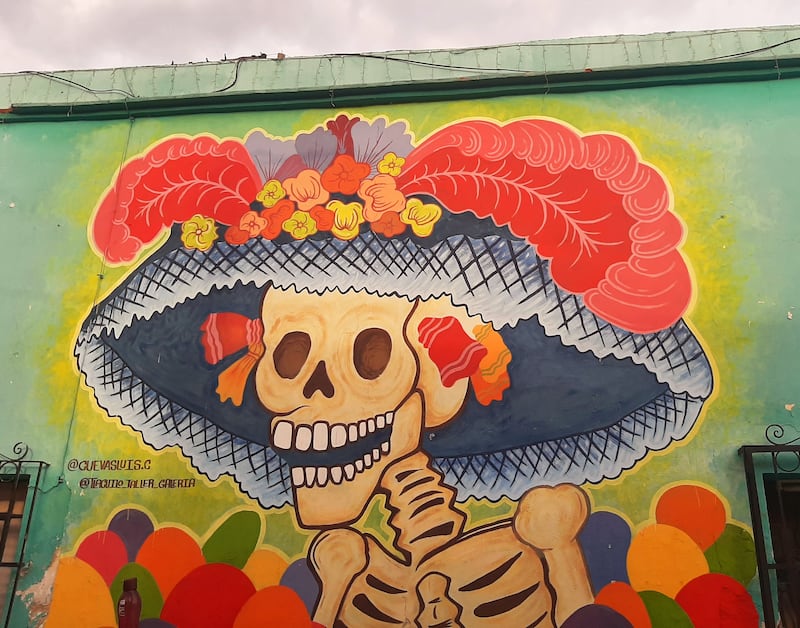
Oaxaca de Juarez, a state capital with a population of around 700,000, turns out to be a completely different world to the one we’ve just left. For one, much of the city is walkable. And planning laws restrict the height of most buildings to two storeys and the colour palette to two colours, creating a charming, small-town effect.
Known as Mexico’s food capital, the city wears its culinary badge proudly. For breakfast, our B&B serves up chilaquiles verdes y rojos (tortilla chips softened in salsa), huevos zapotecos (scrambled eggs with cactus, tomato and onion, served with black beans and tortillas), and lots of salty, stringy Oaxacan cheese.
On a free walking tour, our guide tells us about the region’s 16 indigenous languages, and the various festivals it hosts throughout the year. On the most famous of these, Dia de Las Muertos (the day of the dead), the population swells with visitors as the city comes alive with parades.
Activity revolves around the zócalo (main square), home to restaurants, markets, government buildings, shoe shiners. Bunches of balloons and children’s toys are for sale on every corner. Day after day, dozens of protesters stand in remonstration over young people who went missing in suspicious circumstances.
Demonstration is not unusual in this politically engaged city. Messages in support of Palestine, or against gentrification, are scrawled on walls everywhere. Hawkers tout bracelets with messages including F**k Trump, Dump Trump.
On a separate, street-art tour, we learn about the activist messages in some of the murals. Others contain more whimsical, or mystical, meanings. La Catrina – the skeleton woman with the wide-brimmed hat – recurs, a symbol of the Mexican attitude towards death. So too does the xoloitzcuintli, a breed of hairless dog believed to be the guardian of the other world. If the living person has treated animals badly, our guide tells us, their soul will be refused entry to heaven.
In the markets, rows of dead chickens hang naked for sale. You can eat a grasshopper, if you dare. The comida corrida (food corridor) at Mercado 20 de Noviembre, is a chance to sample a three-course offering of local cuisine for around $100 MXN (€4.50).
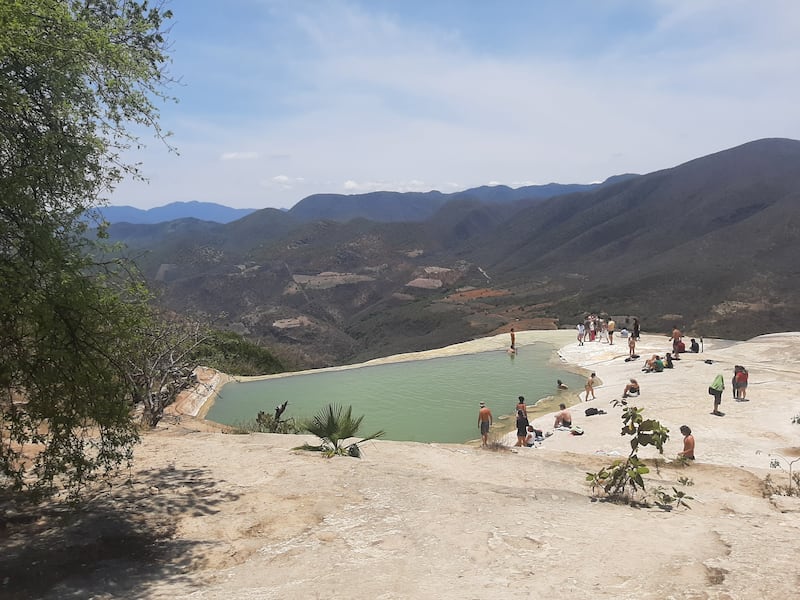
Once again, we find ourselves with more to see than could ever fit into our itinerary. Hierve el Agua, one of only two petrified waterfalls in the world, seems a standout choice.
The bus climbs and climbs, up the Sierra Madre Sur. From the car park, we hike into the valley, where we can touch the smooth travertine rock formation, then back up again, in sweltering 35 degree heat. At the summit, mineral pools sparkle tantalisingly at the edge of a cliff. Other tourists are already bathing, taking Insta-perfect photos.
We strip to our swimsuits and lower ourselves in, then wade to the edge. Acres of green trees and fields stretch for miles below. Mountains stand resplendent in the Mexican sky. Birds of prey swirl hypnotically overhead. Our shoulders are burning, but we don’t feel it, up here, on top of the world.




















